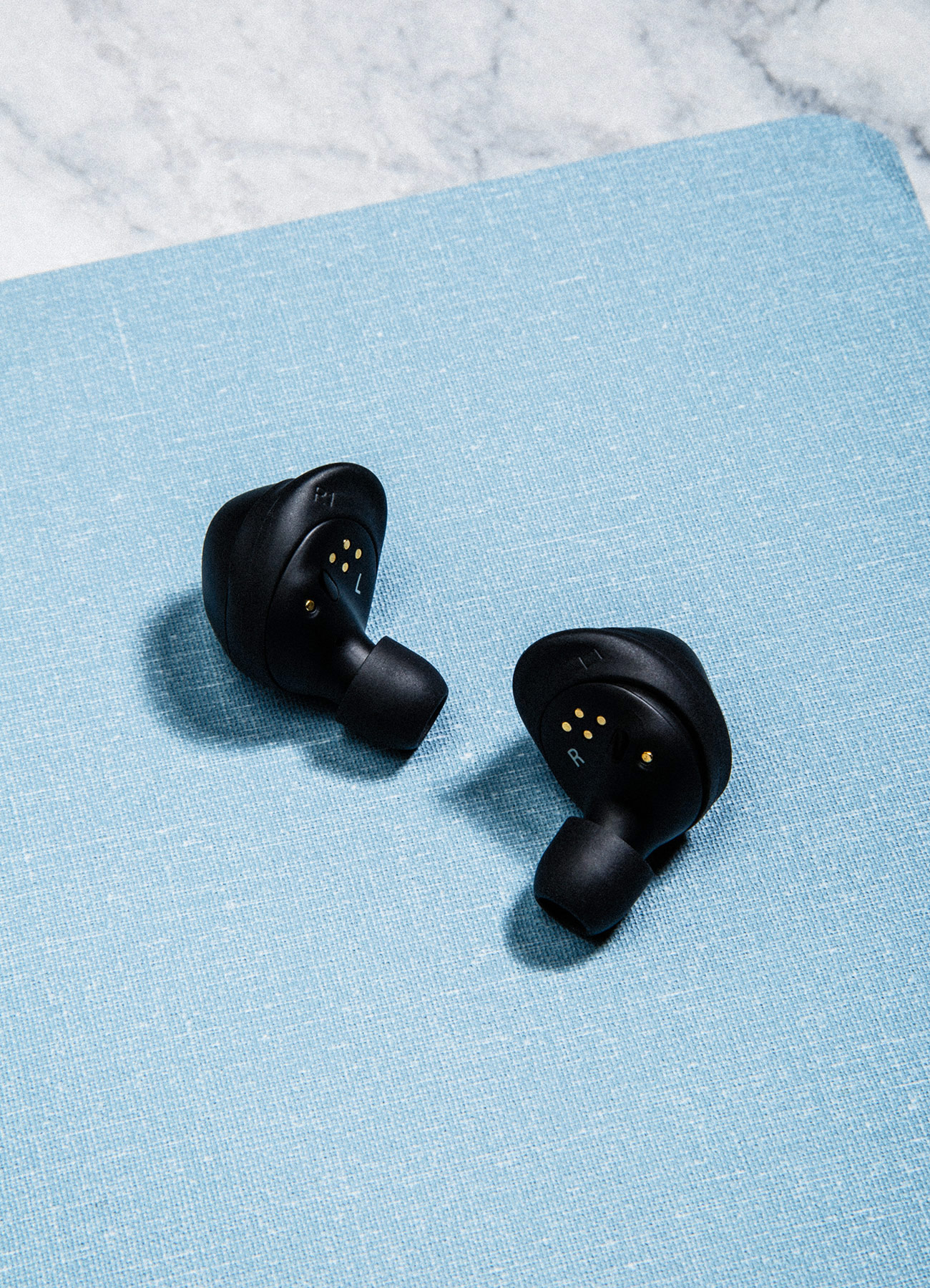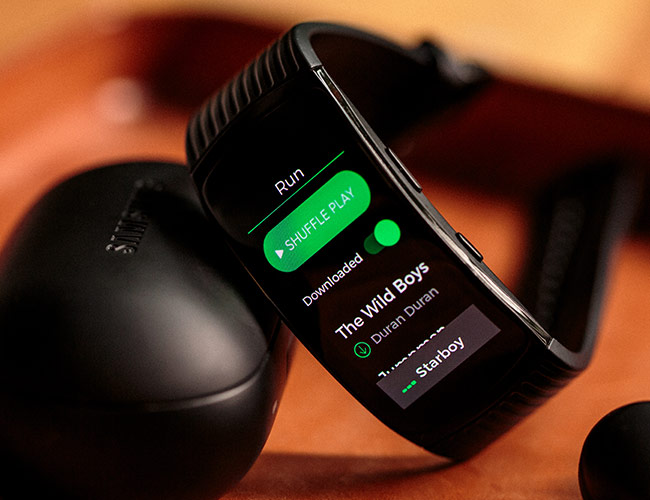Samsung’s first truly wireless earbuds, the IconX, were released in 2016 and were packed features (especially for working out), like 4GB of onboard storage and a built-in heart-rate sensor. But they also came with several of issues: many reviewers noted poor battery life and issues with the swipe gestures that controlled the volume and play/pause on the actual earbuds. Samsung has since released its second-generation IconX earbuds ($154+) that replaced the first-gen models. The new earbuds have better battery life (thanks to no heart rate sensor), fast charging capability, Bixby integration and can even track your runs without needing your smartphone nearby. They also have a redesigned charging case that’s less-elongated, slightly bigger and charges via USB Type-C.
The Good: The best thing about the IconX earbuds is their fit. They come with swappable sets of ear tips and ear wings, so they really stay in my ears. The earbuds are also tiny, so they fit snug and never feel like they’re about to fall out of my ears, which I can’t say about the Bose SoundSport Free or Jabra Elite 65t. They’re also sweat-resistant, unlike AirPods. Sound quality is good and reliable, which is all I can ask for a truly wireless pair of earbuds. They come with other neat fitness and coaching features for those hedged with Samsung’s Health app, which is available on both Android and iOS; it can track metrics such as calories burned, distance traveled and speed. The digital “coach” can explain how I do throughout my workout. The charging case is itself charged via USB Type-C, so I could use the same charger with them as my MacBook Pro.
Who It’s For: The IconX earbuds are really designed for people with a Samsung Galaxy smartphone. But you don’t have to have one — the IconX work like any other Bluetooth headphones.
Watch Out For: The second-generation IconX earbuds aren’t perfect. The swipe controls are still a little finicky, but the biggest issue I had was with the charging case. Most times I put the earbuds back in their charging case, the earbuds stayed on and stayed connected to my smartphone — this drained their battery life when I wasn’t using them. It was also annoying because when I wanted to listen to a video on my Galaxy S9, as the audio was still playing on the earbuds even though they were locked in the charging case, so I couldn’t hear anything. Jeffrey Van Camp of Wired had a similar issue: “It’s strange that even though the buds know when they’re out of my ears thanks to a sensor, they aren’t intelligent enough to automatically shut off, too.” To compensate, I ended up charging the IconX and their charging case more often than I needed to. The second-gen models started at $200, which is expensive but wait a few months and you can pick them up for roughly $50 less on Amazon.
Alternatives: There are several alternatives. If you’re looking for more fitness-focused, truly wireless earbuds, I’d go with Jabra Elite 65t or possibly the Jabra Elite Active 65t, which are more fitness-focused models, when they are available in the near future soon. Anker’s Zolo Liberty are the most affordable alternative, at less than $100. If it’s sound quality you’re after, I’d go with the Bose SoundSport Free or B&O Beoplay E8. However, the runaway leader in this continues to be AirPods, although they’re not sweatproof so I wouldn’t recommend running with them. (Apple is rumored to be releasing water-resistant AirPods later in 2018, see here.

The Verdict: The main thing with wireless running headphones, or any workout headphones, really, is fit — do they stay in your ears? And IconX stayed in my ears better than any other pair I tested. Better than AirPods. Better than Bose’s earbuds. Better than Anker’s new affordable ones. Better than any of them. That’s the main reason why I the IconX are my favorite truly wireless earbuds for running. Truth be told, I also loved running with these headphones because paired with Samsung’s Gear Fit2 Pro fitness tracker, I could listen to Spotify playlists offline and run without having to carry my smartphone — it was a combination of fit and freedom, and it was perfect. I know that most people won’t have this combination, and that’s part of the reason why these IconX earbuds won’t be for everybody. You can also listen to music sans phone if you upload playlists onto the earbuds, but this is a tedious process and the end result doesn’t allow you to easily navigate between songs, so I wouldn’t recommend it. There are a lot of other features that I haven’t hit on, like Bixby integration and fitness tracking, but that’s because most people probably won’t use them. The bottom line, for me, is that if you’re looking for truly wireless earbuds for running that sound pretty good and stay in your ears, these are great. And now they’re decently affordable. Just be aware that the charging case has some issues.
What Others Are Saying:
• “The new IconX are good enough to encourage such heavy use in a way that the original pair never did. They may not have the kind of magic touches of something like AirPods’ instant and effortless pairing, or the rich sound of the Bose SoundSport Free, and Samsung isn’t throwing in everything but the kitchen sink like Bragi does with the Dash. Instead, Samsung’s found a sweet spot between all three, and that idea sounds really good.” — Sean O’Kane, The Verge
• “The buds don’t track heart rate like last year’s model, but they will give you a rough (very rough) approximation of the distance you traveled and steps you took during a workout. Samsung’s Bixby woman-like voice talks to you while you run, encouraging you to speed up and updating you on your distance. To get a better idea of your workout in progress, I recommend bringing along a phone or Gear Sport watch.” — Jeffrey Van Camp, Wired
• “In typical Samsung fashion, the Gear IconX offer a lot more features than the typical buyer is probably interested in. One of Samsung’s marketing points for the IconX are the fitness features integrated into the buds themselves. That includes tracking workouts, coaching, calories burned, speed, distance, and more with various sensors. In the very limited testing, I did with those features, they seemed to work well. However, I’d mainly look at these features as added bonuses rather than make or break features.” — Ben Schoon, 9to5Google
Run with music, but without your phone. Read the Story

